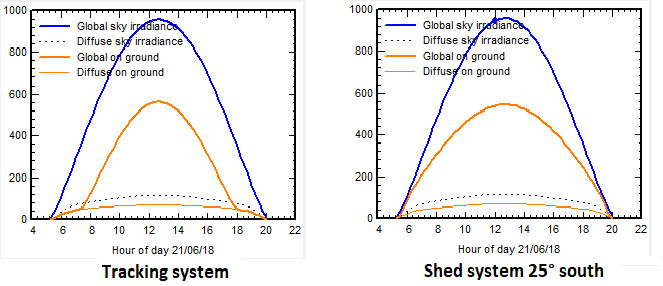Bifacial system: 2-dimensional unlimited trackers
For the basic principles of the bifacial simulation, please click here.
Important Hypothesis
This simplified 2D model is only applicable to large regular tracking systems with horizontal axis. It neglects the edge effects, either at the extremities of the trackers, and on east and west of the extremity trackers.
Therefore, it is not well adapted to experimental systems with few modules.
This basic model treats - for the bifacial (i.e., the backside irradiance) modelling - your subsystem as a generic "Unlimited Trackers" configuration, i.e., with a single axis orientation, identical pitch between trackers, and without considering the tracker's extremities. Note that it also does not differentiate between PV-sensitive areas and non-sensitive frames. Therefore you can use it:
- either directly with a simple system defined with the "Horizontal axis, Unlimited trackers" orientation type,
- or with a 3D model of the tracker arrangement, provided that the subsystem is sufficiently large and regular to be approximated by the "Unlimited trackers" hypothesis.
The application of the model is as follows:
- PVsyst will create an approximate "Unlimited trackers" subsystem associated to your real PV subsystem, just for the calculation of the bifacial features (i.e., the yield associated to the backside irradiance) during the simulation.
- This "added" system should be similar to the 3D subsystem (the part corresponding to the same orientation).
- Prior to the simulation, except the height above the ground, all parameters of this unlimited trackers object will be adjusted according to your real 3D system. The parameters defined in the bifacial dialog are just here for a pedagogic analysis of the bifaciality model in any conditions: they are not used in the simulation. Two optional checkboxes on the bifacial system window however allow to manually adjust the "pitch" and "number of rows" parameters. With this option, these parameters will override the ones from the 3D model, for the backside irradiance calculation.
2-dimensional calculation
The "unlimited trackers" hypothesis allows a simple analytical calculation of the tracker's behavior, namely the mutual shadings from tracker to tracker (or backtracking), considering only one direction perpendicular to the axis for all the calculations (i.e., a 2D model).
The treatment of the different irradiances on the trackers is identical to the sheds 2D model. The pre-calculation of the ground points (irradiance received, view factor integrals), is performed on 7 different trackers positions. Then the simulation will interpolate these values (using cubic splines) at each hour, in terms of the exact position of the trackers.
Tools
Similar tools as those for sheds are available to study tracking systems. We can try to understand all the contributions and behaviors with different drawings in terms of different variables, especially the Tracker's positions, and the Ground-points positions.
In this tool, you can vary the tracker's parameters to analyze the effects. These modifications do not affect the simulation parameters (except the height above ground, which is specified here): before the simulation, PVsyst will reevaluate the parameters, and fix them as close as possible to your existing project.
Performances
Now, we are expecting for a performance that is slighty lower than the shed-like systems. Because the tracking strategy tends to optimize the trapping of sun rays, thus less beam irradiance reaches the ground.
The next figure shows a comparison of the beam attaining the ground, for similar fixed and tracking systems (GCR = 41%):
We can observe that in the morning and evening, the beam acceptance is much lower for tracking systems, falling to null when the mutual shadings (or backtracking) begin.
In our case and for a clear day in June, the beam fraction on ground is 44% with tracking, and 60% with sheds systems.
Other parameters may balance a part of this deficit: the view factor on the back side are similar. But the front gain, as well as the back diffuse irradiance from sky, are better. We can mention that there generally cannot be a "direct" beam contribution from the sky on the back side of trackers.
